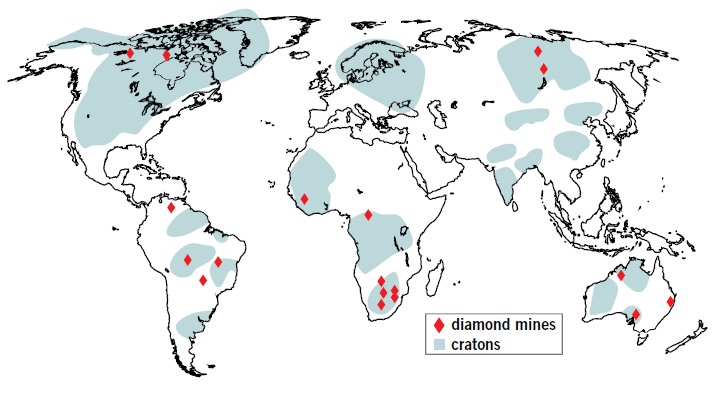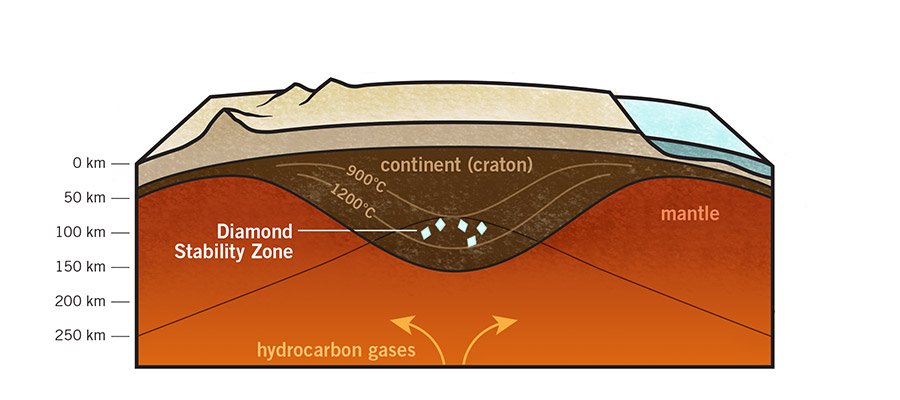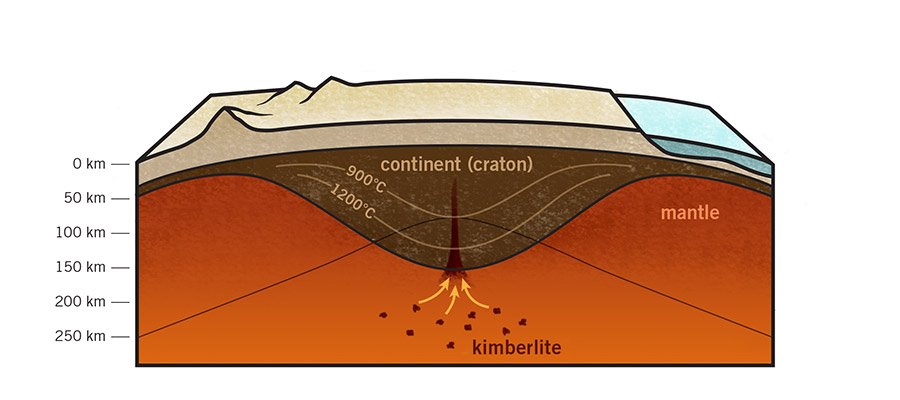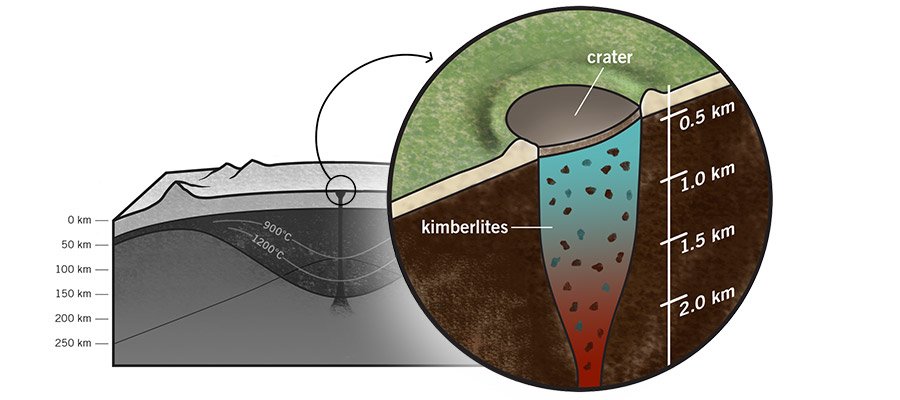
Dazzling Diamonds by Special Delivery
Geology
Diamonds are dazzling but definitely not “ forever.” In fact, they wouldn’t exist without special conditions. God provided those conditions: creation deep in the earth, and rapid delivery during the Flood.
Because of their shimmering beauty, diamonds have been prized throughout history. God even included a diamond among the twelve gemstones on the high priest’s breastplate, representing the twelve tribes of Israel (Exodus 28:18, 39:11). Thus the Creator God looked upon diamonds as things of beauty, purity, and value.
Today, more money is spent on diamonds than all other gems combined. The total value of diamonds mined each year—approximately 130 million carats (more than 57,000 pounds)—is nearly US $9 billion. Diamonds are prized not just for their appearance but for their ultra-hardness. In fact, they are the hardest of all known natural materials, ideal for tools used for polishing and cutting in modern industry. Even Jeremiah speaks of writing on tablets “with a pen of iron” and “with the point of a diamond” (Jeremiah 17:1).
“Diamonds are forever,” the saying goes. But, in fact, they are not stable, at least in the heat and pressures inside the earth. They can survive in only a narrow zone known as “the diamond stability zone.” At higher or lower depths, they quickly break down into graphite, the soft (and more stable) form of pure carbon used in pencils. In addition to being unstable, diamonds need just the right conditions to form. That explains why they are so rare.
So how did diamonds form inside the earth, and then pass through all those destructive zones without breaking down into graphite? The answer is two unique events in the earth’s past: Creation and the Flood.
Original Creation of Diamonds
The clue to the origin of diamonds is their location. Diamond deposits are found in only a few isolated locations around the world (Figure 1). Historically, diamonds have been found and mined in southern and central Africa, where some 49% of diamonds originate. However, today large deposits are found in specific regions of Siberia, Canada, Australia, and Brazil.
The common denominator is unique areas of particular rock types known geologically as the “cratons.”1 Cratons consist of the foundational basement rocks of the continents, before they broke apart during the Flood and were covered by fossil-bearing sedimentary layers. These basement rocks were likely formed back in the Creation Week.
Diamonds apparently formed at the roots of these cratons. Why do we think this?
One clue is the radioisotope markers in the diamonds that match those of the basement rocks. (Based on occasional minute inclusions within them, diamonds are claimed to be 1–3.2 billion years old.2 While these secular dates are wrong, the relative radioisotope dating is helpful, indicating that diamonds were formed earlier than the Flood deposits.)
Another clue is that these craton roots are in the diamond stability zone.
Current ideas differ about the original source of the carbon that was converted into diamonds. Some researchers believe that diamonds formed from carbon in methane or other hydrocarbon gases that ascended through the upper mantle from deeper inside the earth. This is consistent with conditions that could have existed on Day Three of Creation Week.
Other scientists suggest that the carbon came from the earth’s surface (and may even be ultimately of biological origin); upheavals in the earth’s crust then pushed the carbon down to these depths. However, the isotopic composition of diamonds rules out that scenario.3
So how did these diamonds reach the surface without breaking down? A good clue is the rock material found with diamonds on the surface.
Host Rock
Diamond deposits are found in the two unusual host rocks that brought them from deep in the earth’s interior to the surface. These host rocks are called kimberlite (named after the best-known and earliest-mined diamond deposits at Kimberley in South Africa) and lamproite.
The diamonds were not part of their host rocks originally. The kimberlites and lamproites were merely vehicles that transported diamonds to the surface. They rose from even deeper inside the earth, and picked up the diamonds as they traveled upward.
Kimberlites and lamproites are volcanic rocks produced from melted (molten) rocks in the earth’s mantle, below the outer crust.4 These molten rocks rose up in three-dimensional shapes called pipes (Figure 2). These pipes look like champagne glasses, narrow at the bottom and splaying out near the surface. At depth the pipe connects with a system of deep fractures. It is along these fractures that the molten rock forced its way upward.
Picking Up Diamonds on the Way to the Surface
Kimberlites and lamproites often contain fragments of other rock types that broke off and were picked up as the molten rock rose from the earth’s interior to the surface. Laboratory studies suggest that these rock fragments formed at high temperatures and pressures found in the earth’s upper mantle at a depth of 87–125 miles (140–200 km). These are the same conditions under which the mineral diamond is known to be stable. At shallower depths, where temperatures and pressures are lower, diamonds are unstable and carbon appears as the mineral graphite.
Some catastrophe in the earth’s past caused localized melting of rocks in the upper mantle, producing molten blobs of kimberlite and lamproite. Since heat causes rocks to expand, these blobs were less dense (and more buoyant) than the surrounding rocks. As a consequence the molten blobs (magmas) began to rise along fractures upward toward the earth’s crust. As the blobs passed through diamond–bearing zones, they picked up diamond crystals and transported them into the crust.
A Catastrophic Ascent
This process must have been extremely rapid; otherwise, the diamond crystals would have reverted to soft graphite.5 Laboratory experiments, coupled with other mineralogical and textural features in kimberlites and lamproites, indicate the ascent was between 6 and 19 miles (10–30 km) per hour. In other words, if these magma “blobs” began their journey at depths of 125 miles (200 km), then they must have blasted to the earth’s surface in only 7–20 hours!
We have never observed any eruptions like this in our modern world. Special conditions during the Flood and earliest post-Flood times, however, would explain these unique events that brought diamonds to the surface for the future amazement and enjoyment of mankind.
What drove this explosive ascent? Within the magmas was the gas, carbon dioxide, under extreme pressure.6 Water was also present under pressure, in the form of superheated steam. This gas and steam would have pounded through the rock like a hydraulic drill, causing fracturing and wedging. Much like soda in a corked bottle, the magmas were ready to enter the rocks above them explosively.
The rising magma got a “second wind” near the surface, leading to a final explosive push upward. Because the magma traveled so rapidly, it had little time to cool. At the shallow depth of 1.25 miles (2 km), the pressure greatly diminished, allowing the superheated steam in effect to boil. At the same time, the magma came into contact with groundwater, which was also boiling from the heat of the rising magma. The net result was an explosive release of energy, much greater than that of the Mount St. Helens blast on May 18, 1980.7 Like a bomb detonating, the magmas punched holes all the way up to the surface. These intense explosions formed chimney-like pipes (Figure 2) unlike anything we see during today’s mild volcanic eruptions. These explosive eruptions were localized and very short-lived, but shattered the rapidly cooling magmas. The fragments ended up filling the pipes.8 The explosiveness is evident in the fragments. Diamond crystals are found with the shattered remains of the magmas.
In the years since the Flood, secondary diamond deposits have formed due to weathering and surface erosion. Diamonds are so hard they survive and end up in gravels, river sediments, and sometimes on beaches, such as along the coast of Namibia in southern Africa.
Time Capsules
Although radioisotope dating is used to claim diamonds are 1–3.2 billion years old,9 diamonds also contain radiocarbon (14C) that instead dates them at thousands of years.10 This has been independently verified.11 Uniformitarians have tried to argue that the measured 14C in the diamonds is contamination from the analytical instrument. However, the 14C is 25 times higher than what the same instrument measures without a sample in it. So the measured 14C is intrinsic to the diamonds, and thus they are only thousands of years old.
This finding is highly significant. We have already seen that the diamonds were formed when the basement rocks formed.12 If the radiocarbon dating method for diamonds gives the correct age, then the basement rocks of the continents are only thousands of years old. Studies by creationists have conclusively demonstrated that radioisotope dating methods have experienced grossly accelerated decay rates, meaning the 1–3.2 billion-year dates are wrong.13 The 14C locked in these diamond time capsules—so hard that they cannot be contaminated—correctly dates not only the diamonds but the earth itself at only thousands of years old.
Thus almost every engaged or married woman in North America—and many other parts of the world—is wearing hard evidence on her left hand that God created a young earth. What a great talking point that can lead to witnessing opportunities!
Conclusions
It appears that God formed diamonds deep inside the earth’s mantle, more than 87 miles (140 km) down, when He laid the foundations of the earth (Job 38:4). Radiocarbon inside these diamonds dates Creation Week and the rocks formed during it at only a few thousand years.
Furthermore, the diamonds were transported to the earth’s surface extremely rapidly by catastrophic processes. Kimberlite and lamproite magmas rapidly ascended through fossil-bearing Flood deposits during the Flood. Within 7–20 hours, each stream of magma explosively formed the diamond-bearing pipes that we mine today.
The next time you stare into a sparkling diamond with its bewitching beauty, remember that it speaks about more than beauty. Based on its chemistry, we know God formed it deep inside the earth during Creation Week. And the only reason you can admire it today is the rapid changes within the earth during the Flood, when God catastrophically judged the earth because of man’s sin. God delights in giving “beauty for ashes” (Isaiah 61:3). What a testimony diamonds are to our Creator Jesus Christ, who endured the judgment for our sins on the Cross to become our beautiful Savior!
Answers Magazine
April – June 2015
The eruption of Mount Saint Helens in the 1980s changed how we view catastrophe; on its thirty-fifth anniversary, we examine what we’ve learned since then.
Browse IssueFootnotes
- J. J. Gurney, “Diamonds,” in Kimberlites and Related Rocks, ed. J. Ross et al. (Melbourne, Australia: Geological Society of Australia and Blackwell Scientific Publications), 2 (1989): 935–965.
- S. B. Shirey et al., “Diamond Genesis, Seismic Structure, and Evolution of the Kaapvaal-Zimbabwe Craton,” Science 297 (2002): 1,683–1,686.
- P. Cartigny, “Stable Isotopes and the Origin of Diamond,” Elements 1 (2005): 79–84.
- D. H. Eggler, “Kimberlites: How Do They Form?” in Kimberlites and Related Rocks, ed. J. Ross et al., (Melbourne, Australia: Geological Society of Australia Inc. and Blackwell Scientific Publications), 1 (1989): 489–504.
- R. H. Mitchell, “Kimberlites and Lamproites: Primary Sources of Diamond,” Geoscience Canada 18 (1991): 1–16.
- G. C. Kennedy and B. E. Nordlie, “The Genesis of Diamond Deposits,” Economic Geology 63 (1968): 495–503.
- C. W. Burnham, “Energy Release in Subvolcanic Environments: Implications for Breccia Formation,” Economic Geology 80 (1985): 1,515–1,522.
- C. R. Clement and A. N. Reid, “The Origin of Kimberlite Pipes: An Interpretation Based on a Synthesis of Geological Features Displayed by Southern African Occurrences,” in Kimberlites and Related Rocks, ed. J. Ross et al. (Melbourne, Australia: Geological Society of Australia and Blackwell Scientific Publications), 2 (1989): 1,007–1,011.
- Ref. 2.
- J. R. Baumgardner, “14C Evidence for a Recent Global Flood and Young Earth,” in Radioisotopes and the Age of the Earth: Results of a Young-Earth Creationist Research Initiative, ed. L. Vardiman, A. A. Snelling, and E. F. Chaffin (El Cajon, California: Institute for Creation Research, and Chino Valley, Arizona: Creation Research Society, 2005), 587–630.
- R. E. Taylor and J. R. Southon, “Use of Natural Diamonds to Monitor 14C AMS Instrument Backgrounds,” Nuclear Instruments and Methods in Physics Research B259 (2007): 282–287.
- J. J. Gurney, et al., “Diamonds through Time,” Economic Geology 105 (2010): 689–712.
- L. Vardiman, A. A. Snelling, and E. F. Chaffin, eds., Radioisotopes and the Age of the Earth: Results of a Young-Earth Creationist Research Initiative (El Cajon, California: Institute for Creation Research, and Chino Valley, Arizona: Creation Research Society, 2005); D. DeYoung, Thousands . . . Not Billions (Green Forest, Arizona: Master Books, 2005).
Recommended Resources

Answers in Genesis is an apologetics ministry, dedicated to helping Christians defend their faith and proclaim the good news of Jesus Christ.
- Customer Service 800.778.3390
- Available Monday–Friday | 9 AM–5 PM ET
- © 2025 Answers in Genesis









